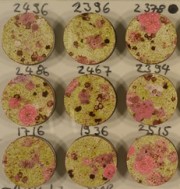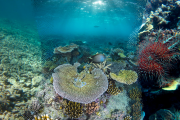NESP TWQ Round 5 - Project 5.2 – From exposure to risk: Novel experimental approaches to analyse cumulative impacts and determine thresholds in the Great Barrier Reef World Heritage Area (GBRWHA)
Understanding cumulative impacts from multiple stressors will be critical for successful management of the Great Barrier Reef (GBR) under the Reef2050 Plan. This project produced experimental analyses of concentration-response relationships for selected species under broad, controlled envelopes of local stressors at different climate scenarios. Results informed assessments of ecological risks, and management opportunities for a range of activities in the coastal zone and on the GBR. In the project-extension used exposure maps and ecological models, based on our developed and existing databases and experimental results, advancing our understanding of the contribution of individual disturbances in a cumulative framework (including both acute and chronic disturbances) to the current status of the reef. In turn, this new knowledge will inform management on setting future water quality thresholds, identifying catchments and regions as priorities for management action aimed at ameliorating impacts to reef health and building resilience for large-scale cumulative disturbances.
Images
Datasets

Understanding cumulative impacts from multiple stressors will be critical for successful management of the GBR under the Reef2050 Plan. The project will produce experimental analyses of concentration-response relationships for selected species under broad, controlled envelopes of sediments, turbidity, nutrients, light, salinity and temperature. Based on new understanding of threshold exposure values, existing and new field data we will produce exposure maps for individual stressors and explore techniques to summarize those into cumulative exposure maps.

Understanding cumulative impacts from multiple stressors will be critical for successful management of the Great Barrier Reef (GBR) under the Reef2050 Plan. This project produced experimental analyses of concentration-response relationships for selected species under broad, controlled envelopes of local stressors at different climate scenarios. Results informed assessments of ecological risks, and management opportunities for a range of activities in the coastal zone and on the GBR.

This dataset consists of one spreadsheet, which shows the survival, number of polyps, size, Symbiodinium quantity and photosynthetic efficiency (Fv/Fm) of up to four-month-old Acropora millepora coral recruits while being exposed to three different climate scenarios resembling current climate conditions and conditions expected by mid and end of the century. Coral recruit resilience towards one-month-long light attenuation with five intensities was tested by exposing the recruits either one (experiment 1) or two months (experiment 2) following settlement.

The dataset consist consists of two (A-B) csv files and one excel file (E). File A shows 1) the absolute percentage total cover and that of specific coral growth forms: Acropora tabular, Acropora branching, other branching species, and massive/submassive species surveyed at 5-9 m depth on 122 reefs (335 reef sites) by the AIMS Long-Term Monitoring Program (LTMP) and Marine Monitoring Program (MMP) between 1992 and 2017 and 2) the long-term average exposure of each reef to variable conditions in water quality (e.g.

This data contains consists of one Excel spreadsheet file containing the thermal stress data used to develop the Species Sensitivity Distribution described in the publication: Negri, A.P., Smith, R.A., King, O., Frangos, J., Warne, M. St-J., Uthicke, S. (2019) Adjusting tropical marine water quality guideline values for elevated ocean temperatures Environmental Science and Technology 54: 1102-1110 DOI: 10.1021/acs.est.9b05961.





